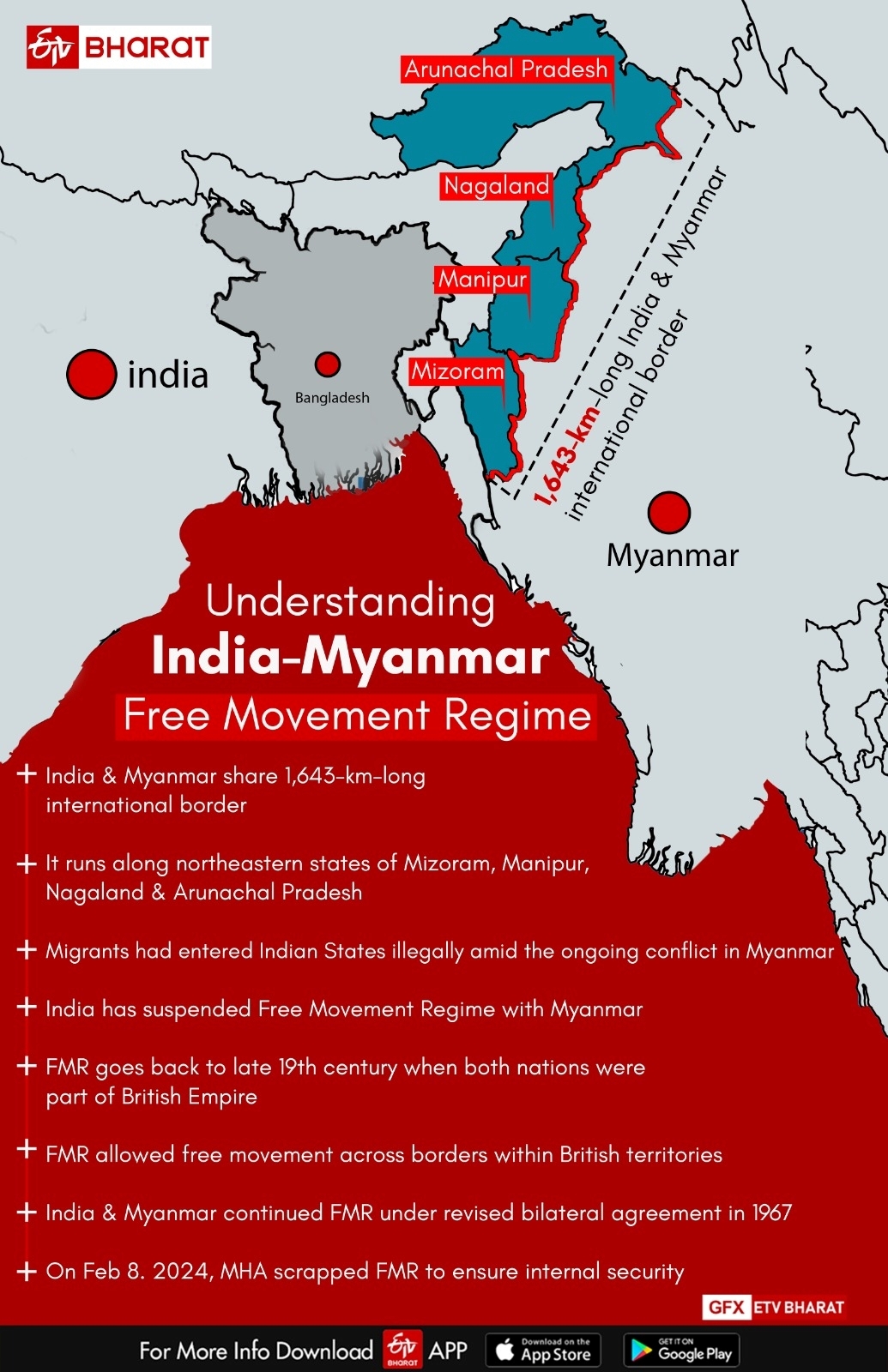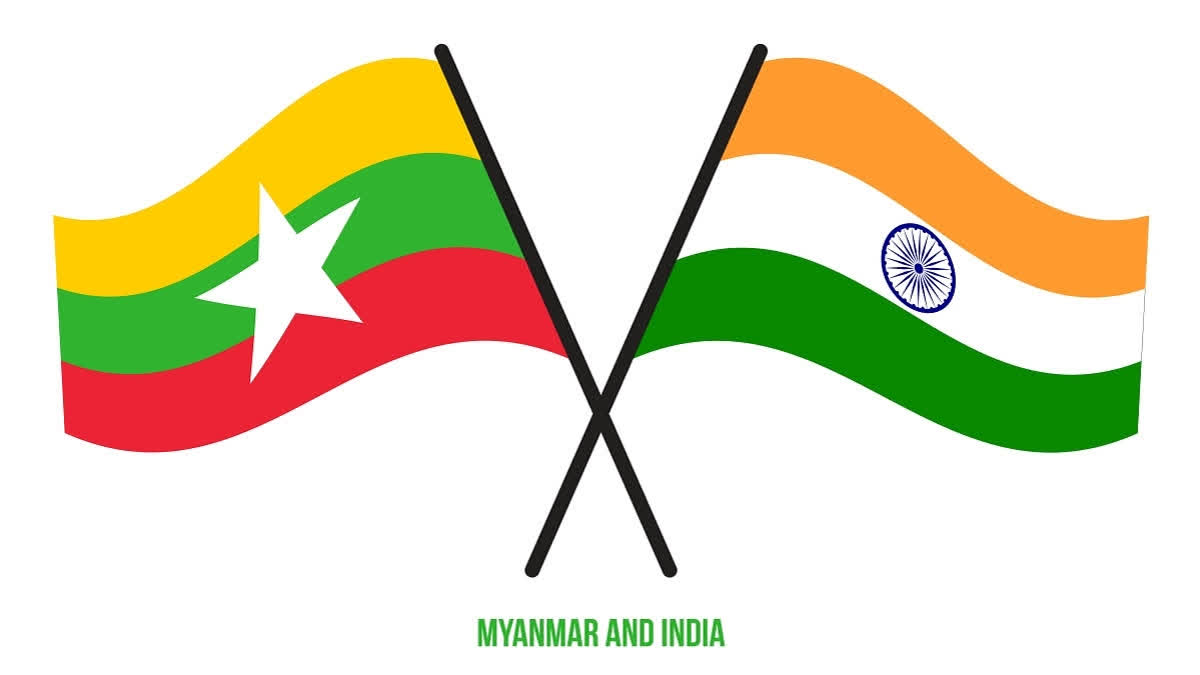New Delhi: Though the Centre decided to suspend the Free Movement Regime (FMR) between India and Myanmar and fence the border between the two countries in the wake of the civil war in New Delhi’s eastern neighbour and the influx of refugees, massive protests in the northeastern states of Mizoram and Manipur, concerns raised by NGOs in Nagaland and resolutions passed in the assemblies of Aizawl and Kohima have stalled the process.
In a post on his official X handle on February 6 this year, Union Home Minister Amit Shah said that the Narendra Modi government is committed to building impenetrable borders. He stated that the government has decided to construct a fence along the entire 1,643-km-long India-Myanmar border to facilitate better surveillance.
“Out of the total border length, a 10-km stretch in Moreh, Manipur, has already been fenced. Furthermore, two pilot projects of fencing through a Hybrid Surveillance System (HSS) are under execution. They will fence a stretch of 1 km each in Arunachal Pradesh and Manipur. Additionally, fence works covering approximately 20 km in Manipur have also been approved and the work will start soon,” Shah stated.
On Thursday, thousands of people participated in rallies in Mizoram and Manipur to protest against the Centre’s decision to suspend the FMR and fence the entire border between India and Myanmar. In February, Mizoram became the first state to pass a resolution in its state assembly opposing the Centre’s decision. Nagaland followed suit in March.
With Civil Society Organisations and NGOs raising concerns over the issue, Nagaland Chief Minister Neiphiu Rio has appealed to them as the Centre has “assured to reconsider the issue” following the resolution passed in the state assembly. “Since the state government is taking all necessary action with the Government of India and the Government of India has also assured to reconsider the issue, the NGOs (non-government organisations) are requested to have patience till the Government of India takes a considered decision in this regard,” media reports quoted Nagaland government spokesperson and Minister of Parliamentary Affairs KG Kenye as saying following a cabinet meeting on Thursday.
However, ETV Bharat has reliably learnt that a decision in this regard is yet to be taken at the highest level at the Centre.
So, what is the FMR all about?
The roots of the FMR go back to the late 19th century when both nations were part of the British Empire. The regulation allowed free movement across borders within British territories. After independence in 1947 (India) and 1948 (Myanmar), the two countries continued the arrangement under a revised bilateral agreement in 1967.

However, India and Myanmar established the FMR in 2018 as part of New Delhi's Act East Policy promoting cross-border movement of people up to 16 km without a visa. Those travelling beyond the 16 km zone require a valid passport and other immigration formalities. The FMR facilitates easier movement and interactions for people residing in the border areas of both nations, allowing them to meet relatives and carry out economic activities.
Individuals residing at the border need a one-year border pass to stay in the neighbouring country. It aimed to facilitate local border trade, improve access to education and healthcare for border residents and strengthen diplomatic ties. Indian citizens can stay up to 72 hours in the 16 km zone inside Myanmar without any formalities. For Myanmar citizens, the limit is 14 days inside the 16 km zone in India.
People in Mizoram and Nagaland especially benefited from the FMR arrangement. The Chin people of Myanmar and the Kuki people of India and Bangladesh are the kindred tribes of Mizos and many of the Mizo migrants in Myanmar have accepted the Chin identity. All of them come under the broader Zo community. In Nagaland, people mainly of the Khiamniungan and Konyak tribes live on both sides of the border.
As such, when the Government of India announced the suspension of the FMR in February this year and decided to erect a fence along the India-Myanmar border, it was met with fierce opposition by the people and state governments of both Mizoram and Nagaland. On the other hand, the Meitei majority people of Manipur and the state government of Manipur as well as the state government of Arunachal Pradesh welcomed the move.
Why did the Government of India decide to revoke the FMR?
Manipur especially has borne the brunt of the negative fallout of the FMR. Following the coup d'etat in Myanmar in 2021 and the subsequent conflict between the ethnic armed organisations and the military junta, there has been a rise in the influx of illegal immigrants, particularly the Chin and Kuki communities from Myanmar, potentially straining resources and impacting local demographics.
Manipur shares a 398-km-long border with Myanmar. It is a porous border enabling illegal drug trade. The Manipur government had declared a 'War on Drugs' to curtail this. This war was targeted against the Golden Triangle comprising the drug cartels of Myanmar, Laos and Thailand. This cartel has forayed into Manipur making it a source of drugs. Over the last five years, poppy cultivation in Manipur has spread to 15,400 acres of land in the hills.
The FMR has also been misused by insurgent groups operating in northeastern India, allowing them to cross the border easily and evade capture. Several insurgent groups from India's northeast region have established camps and taken refuge in the remote border areas of Myanmar's Sagaing Division, Kachin State and Chin State. These groups include the United National Liberation Front (UNLF), the People's Liberation Army (PLA), the United Liberation Front of Assam (ULFA), the National Socialist Council of Nagaland (NSCN), and smaller outfits such as Kuki and Zomi insurgents.
The porous nature of the India-Myanmar border and the FMR that allows unrestricted cross-border movement up to 16 km have facilitated these groups' activities. They have used the areas across the border as safe havens, obtained arms and ammunition, trained cadres, and, more alarmingly, engaged in illicit activities like drug trafficking and arms smuggling to fund their operations.
The misuse of the FMR by these insurgent outfits and the lack of effective border management have contributed to the flourishing of illegal cross-border activities, particularly drug trafficking, across the unfenced borders between the two countries.
Consequently, there is a pressing need for both India and Myanmar to collaborate closely and implement robust measures to strengthen the administration and surveillance of their shared border regions. Such efforts are crucial to curb the menace of drug trafficking, unauthorised cross-border movement and the activities of insurgent groups that threaten the security and stability of the region.
It is against this background that the ethnic conflict erupted in Manipur on May 3 last year after the state's High Court recommended that the demand of the Meiteis for Scheduled ST status be considered. While the Meiteis form the majority population in the state and mainly live in the Imphal Valley, the Kuki-Zomis and the Nagas living in the hills enjoy ST status.
While the Kukis claim that giving ST status will give Meiteis the right to buy land in the hills, the Meiteis say that the conflict is a result of retaliation by the Kukis against the government’s crackdown on drug smuggling from across the border from Myanmar and poppy cultivation in the hills of the state.
Why the sudden protests this week in Mizoram and Manipur?
According to K Yhome, a Fellow at the Asian Confluence think tank, people are thinking that following the abrogation of Article 370 in Kashmir, Article 371 (A) that applies to Nagaland may be at risk. “Earlier this week, a meeting between Civil Society Organisations, NGOs and the Nagaland government was held in Kohima,” Yhome told ETV Bharat over the phone from Kohima. “People are not buying the argument. They are wary.”
It is in light of this that Chief Minister Rio has assured people that the Centre might reconsider the decision on the suspension of FMR and the erection of a border fence. As for the protests this week, Yhome explained that it takes time to mobilise people. The protests in Mizoram and Manipur were organised by the Zo Re-Unification Organisation (ZORO). The ZORO, a prominent and influential Mizo organisation, has long advocated for the reunification of all people belonging to the Chin-Kuki-Mizo-Zomi tribes across India, Bangladesh and Myanmar under one administrative unit. It claims that the former British rulers, during border demarcation, divided the Zo tribal communities into different countries.
Read more: India-Myanmar FMR: Advantages And Challenges



